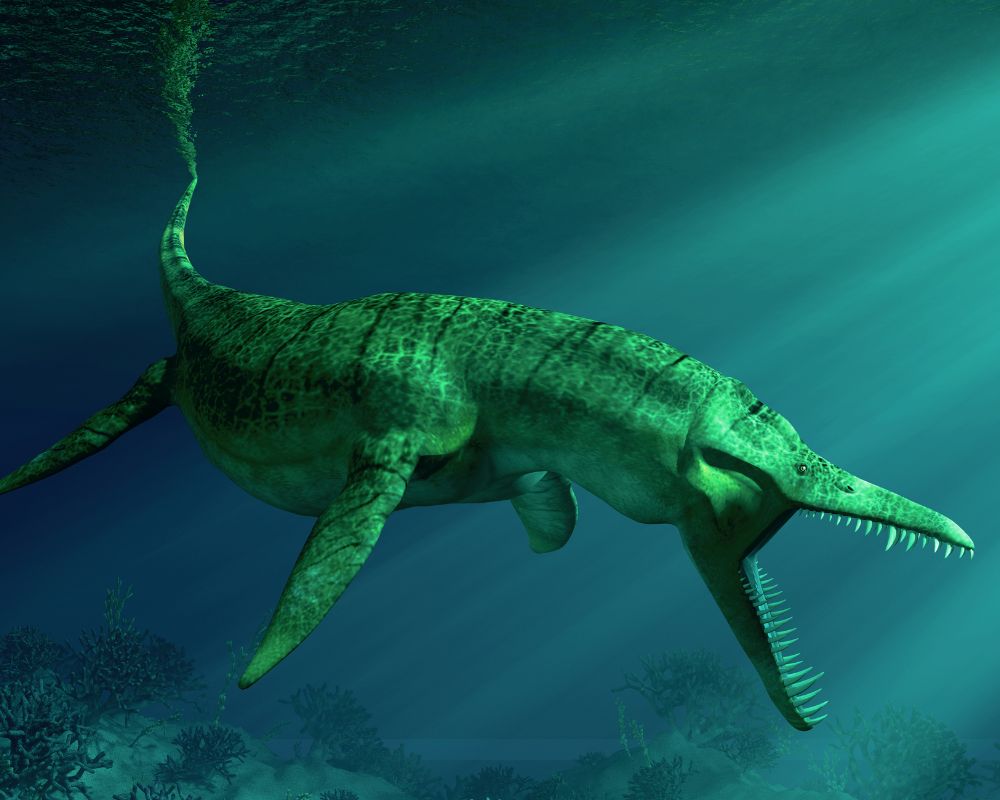In this three-way dino battle, the Livyatan melvillei would walk (or rather, swim) away as the clear winner. This dino had a little bit of everything- it was fast, aggressive, massive, and was a brilliant hunter. The others wouldn’t stand a chance.
Table of Contents
Battle Facts about Livyatan Melvillei vs. Carcharocles Megalodon vs. Liopleurodon

| Name | Livyatan melvillei, Leviathan | Carcharocles megalodon, Otodus megalodon, “big tooth“ | Liopleurodon, “smooth-sided teeth“ |
| Size | 45-60 feet long | 44-56 feet | 16-85 feet |
| Speed | 5-20 mph | 11 mph | 6.2 mph |
| Offense | Massive teeth, quick swimming speeds | Sharp teeth, very fast swimmer | Razor-sharp serrated teeth |
| Defense | A very large body and excellent hearing | Large frame | Heightened sense of smell |
| Endurance and Behavior | Apex predator, very aggressive | Noted as one of the most aggressive sharks in history | A slow swimmer, stalked its prey |
The Livyatan melvillei, Carcharocles megalodon, and Liopleurodon were some of the largest and scariest sea creatures to ever roam the high seas. These creatures had a bite more deadly than a Tyrannosaurus Rex and were about as large as two school buses parked end-to-end. So, which marine mammal reigns supreme? It may not be who you think.
Which type of whale was Livyatan Melvillei?

The Livyatan melvillei was a pre-historic macro raptorial sperm whale that went extinct about 5 million years ago. It was a massive and aggressive sea monster that earned its name from Leviathan, a biblical sea monster, and it was about three times as large as a modern sperm whale.
These giant whales could reach up to 60 feet long (almost two school buses!) and weighed nearly 115,000 pounds. And what made the Livyatan melvillei so deadly was that it was an excellent swimmer that could reach speeds of up to 20 miles per hour.
The Livyatan melvillei has the size of a sperm whale with the aggression of an Orca (or killer whale). That’s one scary combo!
Carcharocles Megalodon: an extinct shark

The Carcharocles megalodon earns the title of the most aggressive shark to ever roam the high seas in the history of planet Earth. It had a very similar jaw to a great white shark, which had a powerful bite.
The bite force of a modern great white shark is just shy of 10,000 pounds per square inch. The bite of the Carcharocles megalodon was about 40,000 pounds per square inch!
To understand how deadly the bite of this giant shark was, the T-Rex had a bite force of 8,000 pounds per square inch. It was game over if you were in the grips of Megalodon’s teeth.
Liopleurodon: a dangerous marine reptile

The Liopleurodon was like a giant Jurassic crocodile swimming in the high seas. It has a lot in common with modern crocodiles, like a long, slender snout accented with razor-sharp teeth and a massive body.
It wasn’t the fastest marine mammal in the sea and could only reach speeds of up to 6.2 mph. It had large flippers, which made it an agile swimmer, but its flippers only slowed it down. Since the Liopleurodon couldn’t outrun its prey, it stalked it. Using its heightened sense of smell, it could stalk its prey, waiting for the perfect moment to strike.
Strength comparison between Livyatan Melvillei vs. Carcharocles Megalodon vs. Liopleurodon
The Livyatan melvillei was much stronger than the Carcharocles megalodon and Liopleurodon. The sheer size of the Livyatan melvillei towered over these other two marine reptiles, and it could hunt down even large prey.
If the Livyatan melvillei could walk on land, it would strike fear in the hearts of other top predators like Tyrannosaurus Rex. While the Carcharocles megalodon and Liopleurodon were strong, they were no match for the Livyatan melvillei.
Was the Livyatan Melvillei bigger than the Megalodon and Liopleurodon?
Yes, the Livyatan melvillei was bigger than Meg and Lio. As with any late Cretaceous creature, the Livyatan melvillei was one of the biggest marine mammals ever to live. It could grow to 60 feet long and weighed about as much as a tank.
The Megalodon came in at a close second, measuring 44-56 feet long. In contrast, the Liopleurodon was about 22 feet long but was just as aggressive and ferocious.
Who would win in a Livyatan Melvillei vs. Carcharocles megalodon vs. Liopleurodon dino battle?
The clear winner of this dino battle of the Miocene era was the Livyatan melvillei. When determining a winner in a dino battle, we must look at their size, speed, aggression, and bite. When comparing these features, the Livyatan melvillei wins on all fronts.
It was bigger, faster, and meaner and had a much more deadly bite when compared to the Carcharocles megalodon or the Liopleurodon.
